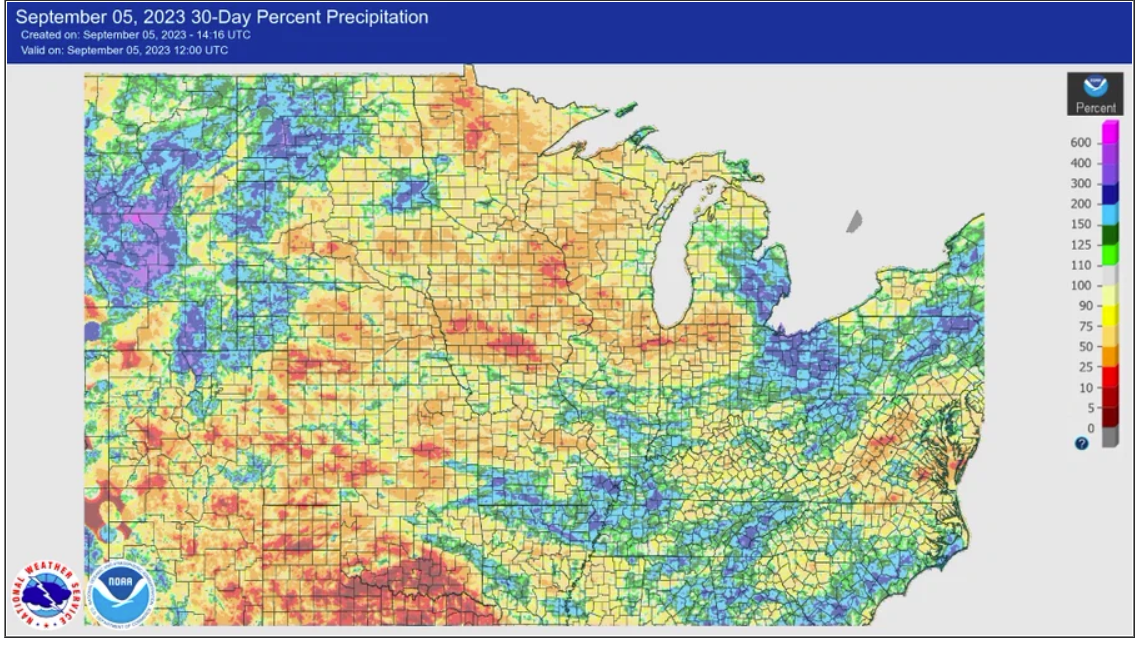Ferrie: Corn Top Dieback And Lack of Uniformity Are Contributing to Unrealistic Yield Estimates Now

The 2023 corn crop in Illinois has endured a pressure cooker of environmental conditions this season.
“I’m not sure what else we can throw at it. It’s endured a cold spring frost, drought, rootless corn syndrome, derecho winds, hail and in some cases heavy rains and now, 100-degree heat,” says Ken Ferrie, Farm Journal Field Agronomist.
The aftermath of heat stress is readily visible in fields throughout much of central Illinois and beyond. The key evidence of the impact is the amount of top dieback in the crop, though Ferrie says there are multiple factors contributing to dieback in addition to the heat.
“While some cases of dieback are heat stress related, some are insect related, others are disease related, and in some cases all the above,” he says.
Anthracnose Top Kill
Anthracnose top kill is fairly prevalent this season. “It's a little random, but I have seen fields with anthracnose ranging from 2% to 70% top kill,” Ferrie says.
To determine whether anthracnose was the cause of top kill, Ferrie tells growers to look for black spores on the outside of the lower stalk of the dead plants.
“When you split the top of the stalk, you’ll also see discoloration. The more the hybrid is stressed, the quicker the problem shows up,” he says.
While fields that were sprayed with a fungicide later in the season tend to show the least amount of anthracnose top kill, fungicide applications won’t have stopped the disease completely, he adds.
High Temperatures Scorched Fields
In many fields, the problem of top kill simply resulted from the high temperatures. This issue was particularly a problem in shorter corn that has an upright leaf structure.
“Many of these fields didn't reach 95% light capture; they had more like 70% capture. With that much sunlight hitting the ground, it turned up the heat just too high,” Ferrie says.
When the end of June and early July rains finally showed up, the rain saved the crop. However, plant growth was finished in many cases, and the crop quickly shifted into reproductive stages.
Corn Planting Dates Were A Factor
Ferrie says corn planted after May 10 was still three to five leaves from tassel when the June 29 derecho hit central Illinois, bringing much-needed rain.
“This corn was still in the vegetative state and is now three foot taller than the earlier planted corn. The rain allowed the May 10 and later corn to reach 95% light capture and keep that plant cooler last week, almost eliminating heat stress,” Ferrie says. “You will notice your more pendulum leaf structure corn will show less heat stress as well.”
Those hybrids with dieback in the top of plants will be pushed to black layer faster and at the cost of kernel depth.
Fields with top kill from the heat may still have good stalk integrity. However, fields with top kill from anthracnose are likely to have more standability issues.
Ferrie advises farmers to start conducting stalk push tests at 30- to 40-degree angles in their crop to see if the stalks will buckle.
“With this stress from top kill, things will speed up and harvest will be here sooner than later and, unfortunately, with less yield,” he says.
Accurate Yield Estimates Needed
Farmers who don’t do realistic yield estimates could be setting themselves up for disappointment this harvest.
“As I do field visits, I see a lot of yields in that 170 to 220 range. I can tell when I announce my findings that most growers are disappointed,” he says. “It's not uncommon for growers to say, ‘Man, when I checked the crop, it came in at 250 to 270.’”

"The USDA rated 53% of the U.S. corn crop as good to excellent, down 3% from last week and beneath analysts' expectations of 54%," Good shared.
"The good-to-excellent ratings for both crops are the lowest for this time of year since 2012, a historic drought year. They have renewed concerns about yields, particularly for soybeans, which are at a critical phase of development."
In Ferrie's opinion with regard to corn, the disconnect between what Illinois growers anticipate and what he believes is more realistic has to do with poor uniformity of stands and ears.
“This year due to rootless corn syndrome and the drought we have the most un-uniform ears that I've seen in some time,” he says. “Most plants have ears, but the shorter plants have half ears. They’ve got good girth, they just don't have length,” he adds.
In this week’s Boots In The Field podcast, Ferrie offers two different methods of making yield estimates. The specific details and directions are available here:







